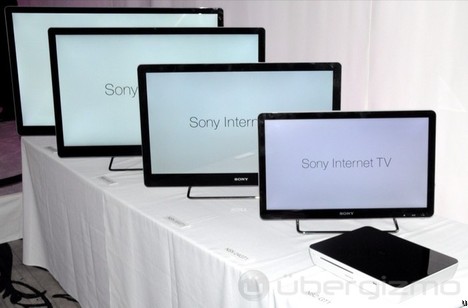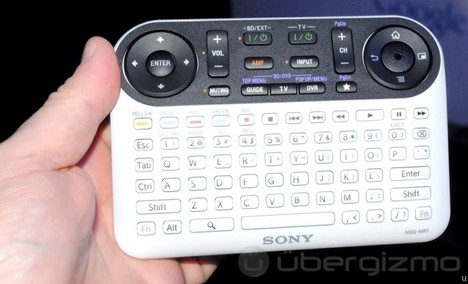
By Stewart Wolpin — It’s only taken 30 years for the promise of PC/TV convergence to finally be realized. Sony has combined with Google to create a true Internet TV, officially Sony Internet TV powered by Google TV. For the purposes of saving key strokes, let’s just call it SIT for the time being.
The big difference between current connected HDTVs and SIT is simultaneous Web surfing and TV watching, what Sony calls “Dual View.” For instance, if you’re watching Law & Order: SVU, you can search for details on the real live crime the story is based on while continuing to watch the episode. If you’re watching a baseball game, you can check on fantasy league stats. The whole idea is to mimic and reduce watching TV with a laptop on your lap to a single screen.

SIT also does system-wide searching – once you start typing characters, SIT starts looking for matches in the cable/satellite program guide, the Web, your DVR, apps, etc. If you locate a future program, you can set the recording with a couple of clicks without leaving the screen.
Using a DLNA connection, you can also access all the content on your PC.

Everything is controlled by a daunting RF learning/universal remote with a QWERTY keyboard and mouse control. And Android smartphone remote control app will be available sometime this fall.
But this is version 1.0 of the Sony/Google marriage, which means the two partners still have a bit to work out.
How big, how much, when
First, the details. There are four models – 24-inch ($599), 32-inch ($799), 40-inch ($999) and 46-inch ($1,399). All are edge-lit LED LCD sets except the smallest, which is old-fashioned CFFL.

There’s also a SIT Blu-ray player that will work with both unconnected and suddenly old-fashioned connected HDTVs.
You can place pre-orders right now at the Sony site. Actual products will go on sale at Sony Style showrooms this weekend and at Best Buy starting Oct. 24.
Sony says it will be the only HDTV vendor with Google HDTV this year, which means we’re likely to see additional Google TV-powered HDTVs from other HDTV makers next year.
How it works

SIT runs on Android, although the OS looks and acts nothing like it does on a smartphone, and is powered by an Intel ATOM processor. All the sets include built-in WiFi, USB jacks, have white backs and are a lot thicker than standard HDTVs.
SITs will run special Android SIT apps – not your cellphone apps. The sets are pre-loaded with more than a dozen apps including CNBC, Napster, NBA, Netflix, Pandora, Twitter, YouTube, and Sony’s own VOD demand service, Qriocity (pronounced “curiosity”). A special SIT Android Marketplace will be created sometime early next year once developers have a chance to get at the Google TV SDK.
During set-up, SIT will find all the connected HDMI gear, especially the cable/satellite box to incorporate the on-screen guide into SIT. Connecting the SIT Blu-ray player, however, requires a daisy-chain. Instead of attaching each of your HDMI components to a dumb HDTV or an receiver, you connect your cable or satellite box instead to the Blu-ray player, which is then connected to the HDTV or receiver.
Does it work?
You’ll have to get used to watching TV in a whole different way. Once you get used to SIT’s logic and learn what all the icons indicate, it’s actually fun to surf and search to locate exactly what you want to watch. All the text is large and easily readable from eight feet away.
Web surfing, either from within the search function or using the Google Chrome app, is a pleasure. It looks, well, just like the Web on your desktop.

But it seems Google had the upper design hand. For one thing, in Dual View, the interface that monopolizes the screen; the TV picture is relegated to a tiny barely watchable PIP in the bottom right corner. When folks watch TV with a laptop in their lap, they don’t have to sacrifice picture size.
Also in a seemingly Google-centric decision, Dual View isn’t automatic – you have to push the remote control Dual View key before you go to the SIT Home screen. Once on and beyond the Home screen, you cannot activate Dual View unless you leave the interface and return to the plain TV view.
As you can see, the remote control is a button-filled nightmare. It’s awkward, if not impossible, to control basic volume/channel functions with one hand – the volume and channel up/down toggles are too far apart, and there’s no 3 x 4 numerical keypad array to casual thumb as you channel surf. To go to a specific channel, you have to use the QWERTY numeric row. SIT’s designers should have taken a lesson from cellphones and Vizio – a remote control with a slide-out QWERTY and standard one-handed remote array on top would have worked much better.
Also missing is a built-in Web cam; it would seem video calling would be a natural extension of the platform.
But, improvements and variety are sure to come as Google TV likely replaces Yahoo! as the preferred connected HDTV platform.

Filed in . Read more about Google, Google Tv, Hands-On, Smart Tv and TV.